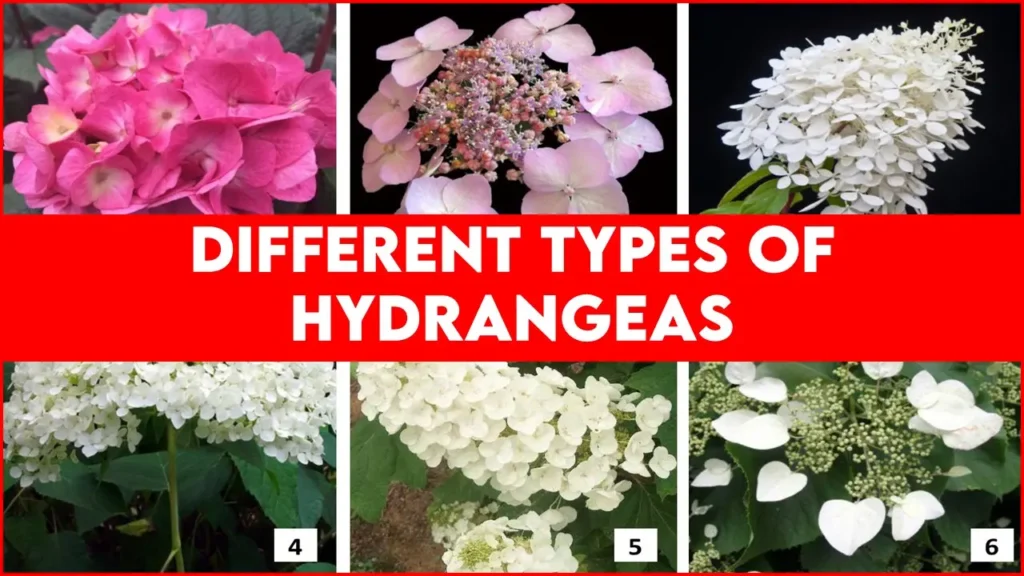Hello my dear Floraphile friends ! Do you want to make your garden more elegant? Let’s learn about 6 different types of Hydrangeas that make your garden more admirable. The difference in Plant geometry and colorful flowers add more aesthetic value to your garden.
What are Hydrangeas?
Hortensia, the common name of Hydrangea, the flowering plants, native to Asia and America. It belongs to the family Hydrangeaceae. Mostly they are shrubs of 1 to 3 m height or may be small trees as well as climbers. They may be evergreen or deciduous in nature. Though the commercially cultivated temperate species are deciduous in nature. The flowers of the Hydrangeas act as natural pH indicators. In acidic soils they flower blue in color and in alkaline soil they flower pink in color.
Different types of Hydrangeas
Here we are going to see about six main different types of hydrangea plants. They may differ in flower color and differ in leaf shape that add more beauty to our garden. They are,
- Big leaf Hydrangea
- Panicle Hydrangea
- Smooth Hydrangea
- Oak- leaf Hydrangea
- Climbing Hydrangea
- Mountain Hydrangea
Now we see the brief description on each type of Hydrangea one by one along with their importance.
1. Big leaf Hydrangea
These are also known as French Hydrangea or Florist’s Hydrangea or Hortensia. They are native to South-Eastern Japan and Southern China. This is the most common type of Hydrangea found widely in the USA. This is known to be a favorite of gardeners. The flowers are generally white, pink or red in color.
| Common name | Big leaf Hydrangea |
| Scientific name | Hydrangea macrophylla |
| Origin | Southern Asia |

It is again classified into two different types. They are,
- Mop head Hydrangea
- Lace cap Hydrangea
i) Mop head Hydrangea (Hydrangea macrophylla)
They are the most popular big leaf hydrangea, highly familiar due to their large flower heads. They produce purple, blue and pink coloured flowers. The leaves are relatively thick and crisp with a shiny appearance and in heart- shaped. The leaf edges are coarsely serrated. The petioles are small and the stems have tiny black or red streaks on them.
ii) Lace cap Hydrangea (Hydrangea macrophylla var normalis)
It is also a different type of hydrangea under this category. The lace cap Hydrangea also looks similar to Mop head Hydrangea and has identical leaf appearance.They differ in the way that the little buds in the center of the lace cap Hydrangea is fertile but the grown flowers in the outer edge are sterile in nature.
Importance :
- It may be an annual or perennial shrub and so it is used for landscaping purposes.
- Its elegant flowers which flower during spring make fantastic matches with other foliage shrubs.
- It gains unique attraction to the viewer when planted in mixed potted shrubs.
- It is used as a bio-indicator of the nature of soil.
2. Panicle Hydrangea
This Hydrangea flower is known for its cone shaped panicle heads. This Hydrangea is native to Eastern China, Japan and Korea. The flowering starts with creamy white flowers and turns pink at its maturity. It bears panicles that are cold and hardy in nature. They thrive in cold hardy regions. The variety H. paniculata ‘Grandiflora’ shows well in cooler climates.
| Common name | Panicle Hydrangea |
| Scientific name | Hydrangea paniculata |
| Origin | South- eastern Asia |

The leaves of this Hydrangea are smaller, thinner and rougher than mop head Hydrangea . The leaves are medium green in colour and lack glossiness. One of the key features of this Hydrangea is that the three leaves grow from a stem-node and are distributed around the node in a whorl. These are the only hydrangeas from trees and have very attractive trunks .
Importance:
- It is the only tree -hydrangea that is used as a specimen tree in landscaping.
- The beautiful white coloured cone shaped panicles give the aesthetic sense to the tree.
3. Smooth Hydrangea
These are also called wild hydrangeas. These are shrubby in nature, native to the USA. These bushes can tolerate hotter climates and it is a hardy crop in nature. Sometimes they are used as hedge plants in Landscaping because of their size.
| Common name | Smooth Hydrangea |
| Scientific name | Hydrangea arborescens |
| Origin | United states of America |

The leaves of H. arborescens are generally heart shaped, thin, and floppier than H.macrophylla. They have a dull surface with coarser texture than the smooth leaf of the mophead hydrangea . The petioles are long and hold the leaf away from the main stem. The stem has a peculiar character that the stem peels off in successive thin layers and shows distinct several colors. Hence it has the common name as “Seven bark”. Smooth hydrangeas are grown more often, because these do fantastic in both warm and cold climates.
Annabelle hydrangea is a famous variety and is a very cold hardy hydrangea that looks similar to mophead hydrangea. The flowers are white and turn into an attractive light green color during maturity. It is a hardy crop which is used as border crops and in flower beds in landscaping.
Also Read
4. Oak leaf Hydrangea
It is named Oak-leaf Hydrangea because its leaves are shaped similarly to the leaves of a red oak tree. It is native to the Southeastern USA. It is a deciduous plant with white flowers. The flowers are small and forms bell shaped appearance, borne in clusters. This plant is best suited for gardening. The leaves of these hydrangeas also change color during the time of fall.
| Common name | Oak leaf Hydrangea |
| Scientific name | Hydrangea quercifolia |
| Origin | Southern USA |

The color of the leaves will change from orange to red to mahogany. This is a beautiful hydrangea that makes a dramatic show in the spring and will grow in light shade or mostly sun. it can also grown in cooler areas where the big leaved hydrangeas are difficult to grown.
Importance :
- The leaf color changing nature of this hydrangea shows a peculiar appearance to our garden.
- It is the best suited shrub for informal gardening ideas.
5. Climbing Hydrangea
Climbing hydrangeas are native to Asia. These are actually climbing vines. They are becoming more popular due to the uniqueness of growing structures and having large blooms.
| Common name | Climbing Hydrangea |
| Scientific name | Hydrangea petiolaris |
| Origin | Asian continent |

These can grow 30 to 80 feet long. These are woody climbing vine grows upto 10-15m long. They grow on rocks and trees found in forest valleys. They can climb by means of aerial roots. They produce white coloured flowers. They are used as ornamental plant. They are widely used in trellis and fences. They provide shade while trained in pergolas and it can also grown in sunshine areas.
| Common name | Japanese Climbing Hydrangea |
| Scientific name | Hydrangea anmola |
| Origin | Himalayan region |
Another important Hydrangea species belongs to this category is Japanese climbing-hydrangea (Hydrangea anomala). These are flowering species native to Himalayan region of the Asian continent. It is a woody climbing plant. The leaves are heart shaped with serrated margin. They produce white coloured flowers with a purple tinge. It is also used for ornamental purposes.
Importance :
- Due to its woody climbing nature, these hydrangeas are used in arches and pergola planting
- It is also used for screening and shading purposes in gardens.
- It is used to make topiary ( the art of making different shapes using shrubs.
6-Mountain Hydrangea:
Mountain Hydrangea, a peculiar type of hydrangea native to Mountains of Korea and Japan. It is also known as ‘ Tea of Heaven’. It is a small deciduous shrub with oval leaves. It produces an inflorescence of Panicles with Blue and pink flowers. It starts flowering in summer and fall in autumn. It is cultivated as an ornamental specimen plant in our home gardens for its elegant flowers. It is propagated by softwood cuttings and also by mound layering.
| Common name | Mountain Hydrangea |
| Scientific name | Hydrangea serrata |
| Origin | Hilly regions of Korea and Japan |

Importance :
- In Japan, the leaves of these flowers are used as a natural sweetener in preparation of Amacha tea, a religious herbal drink, prepared in the celebration of Buddha’s birth.
- It is also used as a hedge plant. In Landscaping, it breaks the monotony of the garden and gives an aesthetic appearance.
Also Read
Conclusion:
“ A sound mind is the sound body”
Gardens are created not only to bring the aesthetic feel into us. It also helps to make our mind and soul relaxed. It brings a peaceful harmony to our soul. Nowadays people believe in natural therapy of healing by Yoga and Meditation. For that they are selecting the gardens as media for connecting their soul peacefully with nature. For such kinds of activities we must make our garden aesthetic sense. Monotony in our garden makes them sometimes feel bored. For that we are using so many different types of hydrangeas, which break the monotony of the garden and bring them pleasure. Shall we make our garden more beautiful? Then make the different types of Hydrangeas as our garden component.
Latest Post
- Top 10 Agricultural Drone Companies in India
- December Issue 2025- Times of Agriculture Magazine
- November Issue 2025- Times of Agriculture Magazine
- Punjab & Sind Bank Introduces Special Program to Support Food and Agro-Processing Sector
- Beyond Classrooms and Gardens: How a Professor Turned His Passion into Purpose
- October Issue 2025- Times of Agriculture Magazine
- Top 10 Pesticide Companies in the World
- September Issue 2025- Times of Agriculture Magazine
- Top 15 Fertilizer Companies in the World











